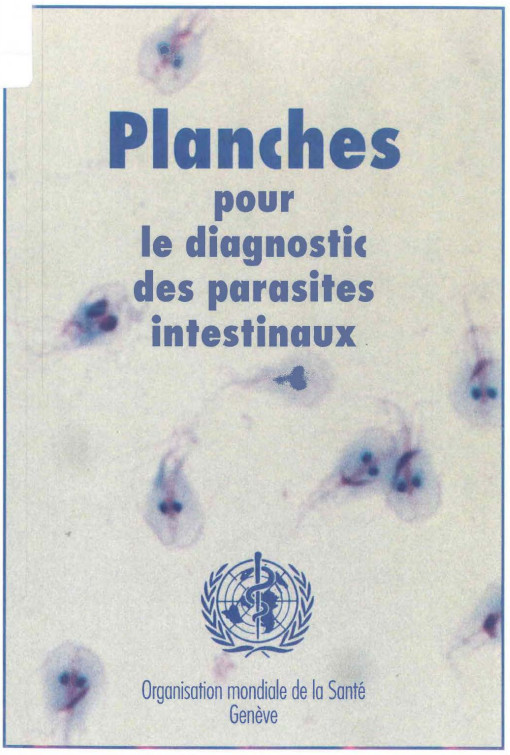Planches pour le diagnostic des parasites intestinaux
 |
Bench aids for the diagnosis of intestinal parasites
Medios auxiliares para el diagnóstico de las parasitosis intestinales
note Jan 1994 ; 23 pages
Ed. WHO - Genève ; Isbn: 92 4 254476 0
Téléchargeable sous format: PdF
Téléchargeable chez l'éditeur
Page de présentation d'un éditeur
Résumé:
Les planches pour le diagnostic des parasites intestinaux sont destinées à servir de guide pour les personnels de laboratoire et de terrain dans les pays d'endémie, et de matériel éducatif pour les étudiants et les stagiaires. On y trouvera des conseils sur la préparation d'étalements directs et colorés de selles pour le diagnostic des helminthes intestinaux ainsi que des formes végétatives et des kystes de protozoaires. Des microphotographies montrent l'aspect et les caractéristiques diagnostiques des parasites dans les divers types de préparations. Abstract:
A set of nine A-4 colour plates with 118 photomicrographs illustrating the appearance and diagnostic features of all the common intestinal helminths and protozoan parasites known to infect humans. Produced in a robust plasticized format, the plates can be used as either a guide for laboratory and field workers in endemic countries or a teaching aid for students and trainees. The aim is to help the microscopist ascertain the presence of parasites in faeces, whether they be minute protozoan cysts or large helminth eggs, and to identify them correctly. With this goal in mind, the bench aids include pertinent laboratory instructions as well as high-quality images. The photomicrographs illustrate diagnostic features of each of the parasites as they appear in different preparations and at different magnifications. Each photomicrograph is produced with a measuring bar and accompanied by a short explanatory legend, which draws attention to distinctive features that help confirm diagnosis. Helminth eggs are illustrated in the first 36 photomicrographs, which show the diagnostic stages of the most common helminths, including nematodes, cestodes, schistosomes, and other trematodes. The remaining photomicrographs offer advice on the more difficult task of detecting and identifying intestinal protozoan trophozoites and cysts. Relevant laboratory techniques are described on the reverse side of the plates. Additional laboratory aids include dichotomous keys for the identification of amoebic trophozoites, trophozoites of intestinal flagellates, and cysts of amoebae and flagellates. Resumen:
Este conjunto de láminas en colores contiene 118 microfotografías que ilustran el aspecto y las características diagnósticas de los helmintos y parásitos protozoarios intestinales más comunes que infectan al ser humano. Las láminas, plastificadas y resistentes, pueden servir de guía para el personal de laboratorio o de campo en los países endémicos o como auxiliar didáctico para estudiantes y personal en adiestramiento. Las microfotografías ilustran características diagnósticas de cada uno de los parásitos tal como aparecen en las diferentes preparaciones y con diferente aumento. Cada microfotografía lleva un segmento de medición y va acompañada de una breve leyenda explicativa que llama la atención sobre las características distintivas que ayudan a confirmar el diagnóstico. Los huevos de helmintos se ilustran en las 36 primeras icrofotografías, que muestran las bases diagnósticas de los helmintos más comunes, inclusive nmatodos, cestodos, esquistosomas y otros trematodos. Las microfotografías restantes asesoran acerca de la tarea más difícil de detectar e identificar los trofozoitos y quistes protozoarios intestinales. En el reverso de las láminas se describen técnicas de laboratorio pertinentes. Otras claves para la identificación de trofozoitos amebianos, trofozoitos de flagelados intestinales y quistes de amebas y flagelados.
Public-Cible:
Mot clef: |
Editeur/Diffuseur: |
|
WHO
-
World Health Organization - Genève - Suisse |
En cas de lien brisé, nous le mentionner à communication@pseau.org